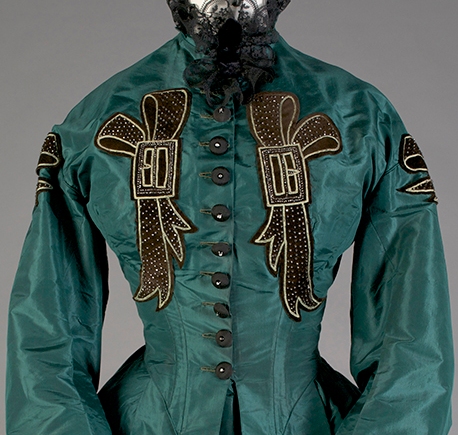
During the second half of the nineteenth century, most women’s dresses were actually composed of a separate skirt and bodice. Generally the waist of the bodice would conceal the waistband of the skirt.
The brown cotton underlining of this bodice provides a beautiful contrast to the green silk taffeta of the outer fabric. The taffeta and cotton layers were cut and sewed as one piece. When the seams were opened, the edge of the taffeta was turned under and finished. The boning was cased in the brown cotton and attached to the inside of the seams.
The skirts by the 1860s were enormous and supported with a steel cage crinoline. In order to maintain body in the bottom edge of the skirt which extended below the bottom hoop of the crinoline, a stiff facing fabric of polished cotton. This skirt actually has two different layers of polished cotton at the hem, with the brown layer extended over a foot from the hem. The hem itself is protected with a braided edge.
- Dress of green taffeta with appliqué bows
Probably American, ca. 1864
Green silk taffeta, black velvet appliqués with steel beads, polished cotton lining, baleen (whalebone)
Silverman/Rodgers Collection, KSUM 1983.1.105 ab

Dress of green taffeta with appliqué bows, KSUM 1983.1.105

The brown cotton underlining of this bodice provides a beautiful contrast to the green silk taffeta of the outer fabric. The taffeta and cotton layers were cut and sewed as one piece. When the seams were opened, the edge of the taffeta was turned under and finished.

The seams on the bodice are finished with piping. The piped edge along the bottom of the bodice is created with a piece of cord inside the bottom facing which is the hand stitched in place once the facing is flipped under.

The boning was cased in the brown cotton and attached to the inside of the seams. The piped edge along the bottom of the bodice is created with a piece of cord inside the bottom facing which is the hand stitched in place once the facing is flipped under.

The neck is finished with a series of triangles along a piped edge.

This skirt actually has two different layers of polished cotton at the hem, with the brown layer extended over a foot from the hem. The stitching to attach the bow-shaped appliqués can be seen through the lining. Rather than creating bulk where the edges of the polished cotton have been turned under, the edges have simply been pinked.

The bottom edge of the skirt is finished with braid to protect from abrasion. This image shows the skirt turned inside out.

The single pocket in the skirt is made from polished cotton, although this fabric is not as heavily waxed and stiff as the lining at the hem.

The extreme fullness of the skirt is brought into the waist with a series of cartridge pleats stitched to the waistband. While the earlier skirts would have been pleated all the way around the waist, by the 1860s, such pleating was only at the back. To add strength, the section that is pleated has been lined with polished cotton.
< Previous item | Next item >










I have to question some of the sweeping statements in the description for this garment. While longer bodices over separate skirts did become very common if not typical starting in the 1870s, separate skirts and bodices were most definitely the exception in the 1850s through most if not all of the 1860s. This late 1860s dress (flat front skirts with gauged backs date to 1866 or later) is a high fashion example of the coming styles. The earlier exceptions would be the occasional basque bodice and skirt that were occasionally worn for a time in the 1850s then again in the 1860s and returning in the 1870s, each time with subtle changes to suit the tastes of the times.
Another comment I question is referring to the thin polished cotton hem facing as ‘stiff’. While there are very rare, formal silk satin wedding dresses with horsehair interfacings under the polished cotton hem facings, they too are exceptions. As a side note, silk and wool dresses generally were lined with polished cotton as they were not washed. Cotton dresses were lined with plain cotton so both dress and lining could be washed.
Glenna Jo Christen
LikeLike